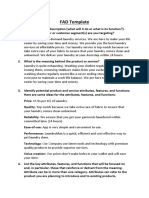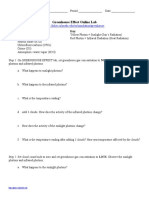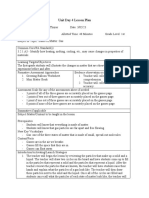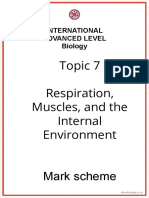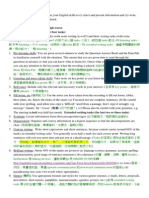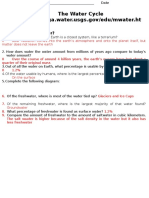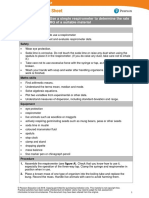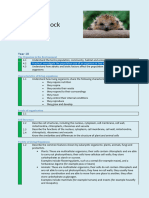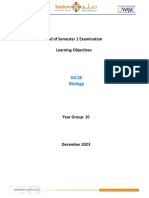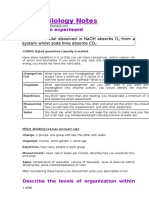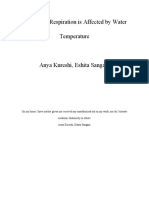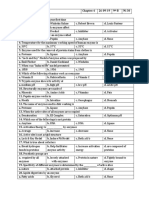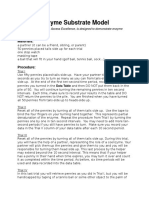Professional Documents
Culture Documents
Y11 SAW 2022 IGCSE Biology (9-1) Syllabus Checklist - SP
Uploaded by
Amjad Saleem0 ratings0% found this document useful (0 votes)
19 views7 pagesIGCSE SYLLABYS CHECKLIST
Copyright
© © All Rights Reserved
Available Formats
DOCX, PDF, TXT or read online from Scribd
Share this document
Did you find this document useful?
Is this content inappropriate?
Report this DocumentIGCSE SYLLABYS CHECKLIST
Copyright:
© All Rights Reserved
Available Formats
Download as DOCX, PDF, TXT or read online from Scribd
0 ratings0% found this document useful (0 votes)
19 views7 pagesY11 SAW 2022 IGCSE Biology (9-1) Syllabus Checklist - SP
Uploaded by
Amjad SaleemIGCSE SYLLABYS CHECKLIST
Copyright:
© All Rights Reserved
Available Formats
Download as DOCX, PDF, TXT or read online from Scribd
You are on page 1of 7
Y11 SAW 2022 Revision Checklist (Specialist) 1
iGCSE Biology (Original Syllabus Order)
At the time of your Y11 SAW exam we will have covered all of the curriculum detail up to the syllabus points
below.
Sections of the syllabus covered:
1. The nature and variety of living organisms (Complete.)
2. Structures and functions in living organisms (Complete except for plant coordination.)
3. Reproduction (Animal only.)
Section 1: The nature and variety of living organisms
1a) Characteristics of living organisms Green Orang Red
e
1.1 Understand that living organisms share the following characteristics:
– they require nutrition
– they respire
– they excrete their waste
– they respond to their surroundings
– they move
– they control their internal conditions
– they reproduce
– they grow and develop.
1b) Variety of living organisms
1.2 Describe the common features shown by eukaryotic organisms: plants,
animals, fungi and protoctists. Be able to give named examples and recall the
following details of each:
Plants: these are multicellular organisms; their cells contain chloroplasts and are
able to carry out photosynthesis; their cells have cellulose cell walls; they store
carbohydrates as starch or sucrose. Examples include flowering plants, such as a
cereal (for example, maize), and a herbaceous legume (for example, peas or
beans).
Animals: these are multicellular organisms; their cells do not contain
chloroplasts and are not able to carry out photosynthesis; they have no cell
walls; they usually have nervous co-ordination and are able to move from one
place to another; they often store carbohydrate as glycogen. Examples include
mammals (for example, humans) and insects (for example, housefly and
mosquito).
Fungi: these are organisms that are not able to carry out photosynthesis; their
body is usually organised into a mycelium made from thread-like structures
called hyphae, which contain many nuclei; some examples are single-celled;
their cells have walls made of chitin; they feed by extracellular secretion of
digestive enzymes onto food material and absorption of the organic products;
this is known as saprotrophic nutrition; they may store carbohydrate as
glycogen. Examples include Mucor, which has the typical fungal hyphal
structure, and yeast, which is single-celled.
Protoctists: these are microscopic single-celled organisms. Some, like Amoeba,
that live in pond water, have features like an animal cell, while others, like
Chlorella, have chloroplasts and are more like plants. A pathogenic example is
Y11 SAW 2022 Revision Checklist (Specialist) 2
Plasmodium, responsible for causing malaria.
Section 1: The nature and variety of living organisms Green Orang Red
e
1.3 Describe the common features shown by prokaryotic organisms such as
bacteria. Be able to give a named examples bacteria and recall the following
details:
Bacteria: these are microscopic single-celled organisms; they have a cell wall,
cell membrane, cytoplasm and plasmids; they lack a nucleus but contain a
circular chromosome of DNA; some bacteria can carry out photosynthesis but
most feed off other living or dead organisms. Examples include Lactobacillus
bulgaricus, a rod-shaped bacterium used in the production of yoghurt from milk,
and Pneumococcus, a spherical bacterium that acts as the pathogen causing
pneumonia.
1.4 Understand the term pathogen and Know that pathogens may include
fungi, bacteria, protoctists or viruses. Be able to give named examples of
pathogen and recall the following details of viruses:
Viruses: these are not living organisms. They are small particles, smaller than
bacteria; they are parasitic and can reproduce only inside living cells; they infect
every type of living organism. They have a wide variety of shapes and sizes; they
have no cellular structure but have a protein coat and contain one type of
nucleic acid, either DNA or RNA. Examples include the tobacco mosaic virus that
causes discolouring of the leaves of tobacco plants by preventing the formation
of chloroplasts, the influenza virus that causes ‘flu’ and the HIV virus that causes
AIDS.
Section 2: Structure and functions in living organisms
The following sub-topics are covered in this section.
(a) Level of organisation
(b) Cell structure
(c) Biological molecules
(d) Movement of substances into and out of cells
(e) Nutrition
(f) Respiration
(g) Gas exchange
(h) Transport
(i) Excretion
(j) Coordination and response
2a) Level of Organisation Green Orang Red
e
2.1 Describe the levels of organisation in organisms: organelles, cells, tissues,
organs and systems.
2b) Cell structure
2.2 Describe cell structures, including the nucleus, cytoplasm, cell membrane,
cell wall, mitochondria, chloroplasts, ribosomes and vacuole.
2.3 Describe the functions of the nucleus, cytoplasm, cell membrane, cell wall,
mitochondria, chloroplasts, ribosomes and vacuole.
2.4 Know the similarities and differences in the structure of plant and animal
cells.
2.5B Explain the importance of cell differentiation in the development of
specialised cells.
2.6B Understand the advantages and disadvantages of using stem cells in
Medicine.
Y11 SAW 2022 Revision Checklist (Specialist) 3
Section 2: Structure and functions in living organisms Green Orang Red
e
2c) Biological molecules
2.7 Identify the chemical elements present in carbohydrates, proteins and lipids
(fats and oils)
2.8 Describe the structure of carbohydrates, proteins and lipids.
2.9 practical: investigate food samples for the presence of glucose, starch,
protein and fat.
2.10 Understand the role of enzymes as biological catalysts in metabolic
reactions.
2.11 Understand how temperature changes can affect enzyme function,
including changes to the shape of active site.
2.12 practical: investigate how enzyme activity can be affected by changes in
temperature.
2.13 Understand how enzyme function can be affected by changes in pH altering
the active site.
2.14B practical: investigate how enzyme activity can be affected by changes in
pH
2d) Movement of substances into and out of cells Green Orang Red
e
2.15 Understand the processes of diffusion, osmosis and active transport by
which substances move into and out of cells
2.16 Understand how factors affect the rate of movement of substances into
and out of cells, including the effects of surface area to volume ratio, distance,
temperature and concentration gradient
2.17 practical: investigate diffusion and osmosis using living and non-living
systems
2e) Nutrition Green Orang Red
e
Flowering plants
2.18 Understand the process of photosynthesis and its importance in the
conversion of light energy to chemical energy affect the rate of photosynthesis
needed for chlorophyll and nitrate ions are needed for amino acids.
2.19 Know the word equation and the balanced chemical symbol equation for
Photosynthesis.
2.20 Understand how varying carbon dioxide concentration, light intensity and
temperature
2.21 Describe the structure of the leaf and Explain how it is adapted for
photosynthesis
2.22 Understand that plants require mineral ions for growth, and that
magnesium ions are needed for chlorophyll and nitrate ions are needed for
amino acids.
2.23 practical: investigate photosynthesis, showing the evolution of oxygen from
a water plant, the production of starch and the requirements of light, carbon
dioxide and
chlorophyll.
Humans
2.24 Understand that a balanced diet should include appropriate proportions of
carbohydrate, protein, lipid, vitamins, minerals, water and dietary fibre.
Y11 SAW 2022 Revision Checklist (Specialist) 4
2.25 Identify the sources and Describe the functions of components of the diet
2.26 Understand how energy requirements vary with activity levels, age and
pregnancy
Section 2: Structure and functions in living organisms Green Orang Red
e
2.27 Describe the structure and function of the human alimentary canal.
2.28 Understand how food is moved through the gut by peristalsis
2.29 Understand the role of digestive enzymes.
2.30 Understand that bile is produced by the liver and stored in the gall bladder
2.31 Understand the role of bile in neutralising stomach acid and emulsifying
lipids
2.32 Understand how the small intestine is adapted for absorption, including the
structure of a villus
2.33B practical: investigate the energy content in a food sample
2f) Respiration Green Orang Red
e
2.34 Understand how the process of respiration produces ATP in living
organisms
2.35 Know that ATP provides energy for cells
2.36 Describe the differences between aerobic and anaerobic respiration
2.37 Know the word equation and the balanced chemical symbol equation for
aerobic respiration in living organisms.
2.38 Know the word equation for anaerobic respiration in plants and in animals
2.39 practical: investigate the evolution of carbon dioxide and heat from
respiring seeds or other suitable living organisms
2g) Gas exchange Green Orang Red
e
Flowering plants
2.40B Understand the role of diffusion in gas exchange
2.41B Understand gas exchange (of carbon dioxide and oxygen) in relation to
respiration and photosynthesis
2.42B Understand how the structure of the leaf is adapted for gas exchange
2.43B Describe the role of stomata in gas exchange
2.44B Understand how respiration continues during the day and night, but that
the net exchange of carbon dioxide and oxygen depends on the intensity of
light
2.45B practical: investigate the effect of light
Humans
2.46 Describe the structure of the thorax, including the ribs, intercostal muscles,
diaphragm, trachea, bronchi, bronchioles, alveoli and pleural membranes
2.47 Understand the role of the intercostal muscles and the diaphragm in
ventilation
2.48 Explain how alveoli are adapted for gas exchange by diffusion between air
in the lungs and blood in capillaries
2.49 Understand the biological consequences of smoking in relation to the lungs
and the circulatory system, including coronary heart disease
2.50 practical: investigate breathing in humans, including the release of carbon
dioxide and the effect of exercise
Y11 SAW 2022 Revision Checklist (Specialist) 5
Section 2: Structure and functions in living organisms Green Orang Red
e
2h) Transport
2.51 Understand why simple, unicellular organisms can rely on diffusion for
movement of substances in and out of the cell
2.52 Understand the need for a transport system in multicellular organisms
Flowering plants
2.53 Describe the role of phloem in transporting sucrose and amino acids
between the leaves and other parts of the plant
2.54 Describe the role of xylem in transporting water and mineral ions from the
roots to other parts of the plant
2.55B Understand how water is absorbed by root hair cells
2.56B Understand that transpiration is the evaporation of water from the
surface of a plant
2.57B Understand how the rate of transpiration is affected by changes in
humidity, wind speed, temperature and light intensity
2.58B practical: investigate the role of environmental factors in determining
the rate of transpiration from a leafy shoot
Humans
2.59 Describe the composition of the blood: red blood cells, white blood cells,
platelets and plasma
2.60 Understand the role of plasma in the transport of carbon dioxide, digested
food, urea, hormones and heat energy
2.61 Understand the adaptations of red blood.
2.62 Understand how the immune system responds to disease using white blood
cells, illustrated by phagocytes and lymphocytes.
2.63B Understand how vaccination results in the manufacture of memory cells
which enable future antibody production to the pathogen to occur sooner,
faster and in greater quantity
2.64B Understand how platelets are involved in blood clotting, which prevents
blood loss and the entry of micro-organisms
2.65 Describe the structure of the heart and how it functions
2.66 Explain how the heart rate changes during exercise and under the influence
of adrenaline
2.67 Understand how factors may increase the risk of developing coronary heart
disease
2.68 Understand how the structure of arteries, veins and capillaries relate to
their function
2.69 Understand the general structure of the circulation system, including the
blood vessels to and from the heart and lungs, liver and kidneys
2i) Excretion Green Orang Red
e
Flowering plants
2.70 Understand the origin of carbon dioxide and oxygen as waste products of
metabolism and their loss from the stomata of a leaf
Humans
2.71 Know the excretory products of the lungs, kidneys and skin.
2.72B Understand how the kidney carries out its roles of excretion and
osmoregulation
Y11 SAW 2022 Revision Checklist (Specialist) 6
2.73B Describe the structure of the urinary system, including the kidneys,
ureters, bladder and urethra
Section 2: Structure and functions in living organisms
2i) Excretion cont. Green Orang Red
e
2.74B Describe the structure of a nephron, including the Bowman’s capsule
and glomerulus, convoluted tubules, loop of Henle and collecting duct
2.75B Describe ultrafiltration in the Bowman’s capsule and the composition of
the glomerular filtrate
2.76B Understand how water is reabsorbed into the blood from the collecting
duct
2.77B Understand why selective reabsorption of glucose occurs at the proximal
convoluted tubule
2.78B Describe the role of ADH in regulating the water content of the blood
2.79B Understand that urine contains water, urea and ions
2j) Co-ordination and response Green Orang Red
e
2.80 Understand how organisms are able to respond to changes in their
environment.
2.81 Understand that homoeostasis is the maintenance of a constant internal
environment. Know body water content and body temperature as examples.
2.82 Understand that a co-ordinated response requires a stimulus, a receptor
and an effector.
Humans
2.86 Describe how nervous and hormonal communication control responses and
Understand the differences between the two systems
2.87 Understand that the central nervous system consists of the brain and spinal
cord and is linked to sense organs by nerves
2.88 Understand that stimulation of receptors in the sense organs sends
electrical impulses along nerves into and out of the central nervous system,
resulting in rapid responses
2.89 Understand the role of neurotransmitters at synapses
2.90 Describe the structure and functioning of a simple reflex arc illustrated by
the withdrawal of a finger from a hot object
2.91 Describe the structure and function of the eye as a receptor
2.92 Understand the function of the eye in focusing on near and distant objects,
and in responding to changes in light intensity
2.93 Describe the role of the skin in temperature regulation, with reference to
sweating, vasoconstriction and vasodilation
2.94 Understand the sources, roles and effects of the following hormones:
adrenaline, insulin, testosterone, progesterone and oestrogen
2.95B Understand the sources, roles and effects of the following hormones:
ADH, FSH and LH
Y11 SAW 2022 Revision Checklist (Specialist) 7
Section 3: Reproduction and Inheritance
The following sub-topics are covered in this section.
(a) Reproduction
3a) Reproduction Green Orang Red
e
3.1 Understand the differences between sexual and asexual reproduction
3.2 Understand fertilisation.
Humans
3.8 Understand how the structure of the male and female reproductive
systems are adapted for their functions
3.9 Understand the roles of oestrogen and progesterone in the menstrual
cycle
3.10B Understand the roles of FSH and LH in the menstrual cycle
3.11 Describe the role of the placenta in the nutrition of the developing
embryo
3.12 Understand how the developing embryo is protected by amniotic fluid
3.13 Understand the roles of oestrogen and testosterone in the development
of secondary sexual characteristics
You might also like
- PRACTICITIONER Reference To Nieper SupplementsDocument95 pagesPRACTICITIONER Reference To Nieper SupplementsClóvis Valadares100% (1)
- The Perfect Answer Revision Guide CIE IGCSE Biology 2Document53 pagesThe Perfect Answer Revision Guide CIE IGCSE Biology 2Bob100% (4)
- FAD TemplateDocument2 pagesFAD TemplateKeshav SinghNo ratings yet
- TEMPLATEDocument10 pagesTEMPLATERuksarNo ratings yet
- Three States of Matter - Realyn D. TanecaDocument11 pagesThree States of Matter - Realyn D. TanecaEya Delos Santos TañecaNo ratings yet
- Plant Reproduction WebquestDocument5 pagesPlant Reproduction WebquestJenny ThomasNo ratings yet
- Phet Contribution 4110 7478Document2 pagesPhet Contribution 4110 7478Charley Ray TaylorNo ratings yet
- Module 11 - Assignment - 1Document9 pagesModule 11 - Assignment - 1Amjad SaleemNo ratings yet
- ZoologyDocument32 pagesZoologyChrisshalyn Sy PinedaNo ratings yet
- Signature Assignment 3 Enzymes 1 1Document4 pagesSignature Assignment 3 Enzymes 1 1api-724481252No ratings yet
- Unit Day 4Document3 pagesUnit Day 4api-653762245No ratings yet
- IB Chemistry DefinitionsDocument4 pagesIB Chemistry Definitionsanon_234967605No ratings yet
- Holy Angel University: School of Arts and Sciences Holy Angel UniveristyDocument3 pagesHoly Angel University: School of Arts and Sciences Holy Angel UniveristyJoshua YutucNo ratings yet
- Paper Title (Use Style: Paper Title) : Subtitle As Needed (Paper Subtitle)Document3 pagesPaper Title (Use Style: Paper Title) : Subtitle As Needed (Paper Subtitle)Momo PierreNo ratings yet
- Newspaper TemplateDocument1 pageNewspaper TemplateJohn ErwingNo ratings yet
- Preparation of Papers For EECCIS J (Petunjuk Penulisan J Eeccis)Document3 pagesPreparation of Papers For EECCIS J (Petunjuk Penulisan J Eeccis)zwartzNo ratings yet
- Lesson Template: Preliminary DetailsDocument7 pagesLesson Template: Preliminary DetailsAnonymous vnflBkNo ratings yet
- Chicago TemplateDocument4 pagesChicago TemplateJt MetcalfNo ratings yet
- Unit 2 Cells Development Biodiversity and ConservationDocument47 pagesUnit 2 Cells Development Biodiversity and ConservationKevir Man100% (1)
- Paper Title Here: Table 1: Center Table Captions Above The TablesDocument2 pagesPaper Title Here: Table 1: Center Table Captions Above The Tablesaa zezen zaenal abidinNo ratings yet
- Checked - Unit 5 Respiration, Internal Environment, Coordination and Gene Technology - Exam - MSDocument20 pagesChecked - Unit 5 Respiration, Internal Environment, Coordination and Gene Technology - Exam - MSEllane leeNo ratings yet
- Checklist ChemDocument46 pagesChecklist Chemadele30No ratings yet
- Alevel Biology Notes U1(需修改补充完善的基础资料,仅供自己复习,Notforsale)Document36 pagesAlevel Biology Notes U1(需修改补充完善的基础资料,仅供自己复习,Notforsale)Jerry SongNo ratings yet
- 1.1 L1 Welcome To IGCSE Economics Class 09ECO2.23Document30 pages1.1 L1 Welcome To IGCSE Economics Class 09ECO2.23ru huiNo ratings yet
- Chemistry AS EdexcelDocument14 pagesChemistry AS EdexcelRaunak PrasadNo ratings yet
- Synopsis TemplateDocument2 pagesSynopsis Templatejoslinmtg100% (1)
- 2 Thought WavesDocument5 pages2 Thought WavesAnonymous oTtlhPNo ratings yet
- Physics A2 ExperimentsDocument55 pagesPhysics A2 Experimentskaos 99No ratings yet
- HL BIOLOGY PAST QUESTIONS PAPER PrintingDocument192 pagesHL BIOLOGY PAST QUESTIONS PAPER PrintingFaizaNo ratings yet
- Company Profile - Huaming EnergyDocument2 pagesCompany Profile - Huaming EnergyKevin XuNo ratings yet
- Study Guide TemplateDocument5 pagesStudy Guide TemplateArgoNavisNo ratings yet
- Paper 3Document18 pagesPaper 3Anonymous IzCd4QXNo ratings yet
- ACTIVE Learning ECE PDFDocument24 pagesACTIVE Learning ECE PDFNiena QieranaNo ratings yet
- Checked - Unit 5 Respiration, Internal Environment, Coordination and Gene Technology - Exam BookletDocument63 pagesChecked - Unit 5 Respiration, Internal Environment, Coordination and Gene Technology - Exam BookletEllane leeNo ratings yet
- Physics 4 Review: Topic 1 Further MechanicsDocument7 pagesPhysics 4 Review: Topic 1 Further MechanicsJerry SongNo ratings yet
- Impressionism in MusicDocument2 pagesImpressionism in MusicMoses LiNo ratings yet
- Igcse Chemistry Revision Final!!Document126 pagesIgcse Chemistry Revision Final!!sohaila ibrahim100% (1)
- Cryptonomicon: The Ancient Origins of Cryptography: Uncovering the Secrets of Ancient Encryption Methods and the Evolution of Cryptography: Cryptonomicon: Unveiling the Roots of Digital Currency, #1From EverandCryptonomicon: The Ancient Origins of Cryptography: Uncovering the Secrets of Ancient Encryption Methods and the Evolution of Cryptography: Cryptonomicon: Unveiling the Roots of Digital Currency, #1No ratings yet
- Award 4Document10 pagesAward 4Bolverk DarkeyeNo ratings yet
- Final Answer Key-WebsiteDocument6 pagesFinal Answer Key-Websiteapi-292258241No ratings yet
- Award 17 CC Zain Church of LightDocument10 pagesAward 17 CC Zain Church of LightBolverk DarkeyeNo ratings yet
- Lesson Overview: 3.4 Cycles of MatterDocument46 pagesLesson Overview: 3.4 Cycles of MatterAhmed YasserNo ratings yet
- Background Chemistry For BiologistsDocument14 pagesBackground Chemistry For BiologistsdR SHAMMIR AHMEDNo ratings yet
- Process of Cellular RespirationDocument11 pagesProcess of Cellular RespirationAlliah Vance O. CapuzNo ratings yet
- Basic Economics Ideas and Resource AllocationDocument10 pagesBasic Economics Ideas and Resource AllocationWaseem AhmedNo ratings yet
- 4.5 Sexual Reproduction in Flowering PlantsDocument17 pages4.5 Sexual Reproduction in Flowering Plantsbee lingNo ratings yet
- Chapter - 7: Control and CoordinationDocument30 pagesChapter - 7: Control and Coordinationuma mishraNo ratings yet
- Church of Light CC Zain Award 12Document8 pagesChurch of Light CC Zain Award 12Bolverk DarkeyeNo ratings yet
- Transport in Plants HandoutDocument5 pagesTransport in Plants HandoutAsawni McDowellNo ratings yet
- The Carbon CycleDocument3 pagesThe Carbon CycleRyan NegadNo ratings yet
- Water Cycle WebquestDocument6 pagesWater Cycle Webquestapi-330037580100% (1)
- IAL Bio SB2 Practs CP16 StudentDocument3 pagesIAL Bio SB2 Practs CP16 StudentCherrysodaNo ratings yet
- Apes Food For Thought Trophic LevelsDocument5 pagesApes Food For Thought Trophic Levelsapi-237699934No ratings yet
- Virtual LabsDocument13 pagesVirtual Labsmnica1977100% (1)
- Etheric Vision and What It Reveals PDFDocument2 pagesEtheric Vision and What It Reveals PDFJuan50% (2)
- X-7-Control and CoordinationDocument30 pagesX-7-Control and CoordinationArohan BuddyNo ratings yet
- Paper 1 Mock For Y11 2023Document4 pagesPaper 1 Mock For Y11 2023005948No ratings yet
- !Y10 Revision Guide BookletDocument10 pages!Y10 Revision Guide BookletjamieNo ratings yet
- Biology SpecificationDocument15 pagesBiology SpecificationazhanNo ratings yet
- Edexcel IGCSE BiologyDocument11 pagesEdexcel IGCSE BiologySweetygirl_16100% (2)
- Edexcel IGCSE BiologyDocument11 pagesEdexcel IGCSE BiologytopsyisgayNo ratings yet
- Biology Year 10 EOS1 LO BookletDocument22 pagesBiology Year 10 EOS1 LO Booklet29x4rk8pgfNo ratings yet
- 10 Biology RevisionDocument8 pages10 Biology RevisionTristanNo ratings yet
- Edexcel International BiologyDocument10 pagesEdexcel International Biologyseharpreet307No ratings yet
- Nelson Advance Functions Answers Chapter 2Document24 pagesNelson Advance Functions Answers Chapter 2Amjad SaleemNo ratings yet
- Module 1 - AssignmentDocument2 pagesModule 1 - AssignmentAmjad SaleemNo ratings yet
- Nelson Advance Functions Answers Chapter 1Document24 pagesNelson Advance Functions Answers Chapter 1Amjad SaleemNo ratings yet
- Module 1 A B C Pointers To ReviewDocument6 pagesModule 1 A B C Pointers To ReviewAmjad SaleemNo ratings yet
- PG SyllabusDocument328 pagesPG SyllabusHishar Mirsam100% (1)
- MetabolismDocument27 pagesMetabolismAnum RasoolNo ratings yet
- Unit One Enzymes: General PropertiesDocument24 pagesUnit One Enzymes: General PropertiesHUAWEI HUAWEINo ratings yet
- Biological Functionality of Ellagic Acid: A Review: D.A. Vattem and K. ShettyDocument33 pagesBiological Functionality of Ellagic Acid: A Review: D.A. Vattem and K. ShettyGeorgiana BerbeceNo ratings yet
- Introduction To BiochemistryDocument97 pagesIntroduction To BiochemistryTsiamo AristideNo ratings yet
- Biology Assignment No: 3 Chapter No:3: Syeda Tabir ZehraDocument5 pagesBiology Assignment No: 3 Chapter No:3: Syeda Tabir ZehraSyeda ZehraNo ratings yet
- Pharma Iii To Viii PDFDocument57 pagesPharma Iii To Viii PDFRaja PrabhuNo ratings yet
- Pharmacodynamics, PharmacokineticsDocument7 pagesPharmacodynamics, PharmacokineticsSammee RegoraNo ratings yet
- Biotechnological Importance of EnzymesDocument15 pagesBiotechnological Importance of EnzymesAmjadNo ratings yet
- 3.2 Cell Transport PDFDocument146 pages3.2 Cell Transport PDFtess_15100% (1)
- IGCSE Biology Notes Updated April 2016Document94 pagesIGCSE Biology Notes Updated April 2016Adi101010101010101100% (1)
- Enzyme KineticsDocument19 pagesEnzyme KineticsParinita Mitchelle MandhyanNo ratings yet
- Chapter 1,2,3 MCQDocument2 pagesChapter 1,2,3 MCQAbdul qadoosNo ratings yet
- Gómez Et Al (2018) Physicochemical Evaluation of Low-Fat YoghurtDocument7 pagesGómez Et Al (2018) Physicochemical Evaluation of Low-Fat YoghurtTahir AliNo ratings yet
- AP Lab #6 Cellular RespirationDocument7 pagesAP Lab #6 Cellular RespirationAnya KureshiNo ratings yet
- EnzymeDocument9 pagesEnzymepooyenpengNo ratings yet
- JMB 28 314 PDFDocument9 pagesJMB 28 314 PDFkenneth ogocNo ratings yet
- Peripheral Testosterone MetabolismDocument8 pagesPeripheral Testosterone MetabolismAgung SentosaNo ratings yet
- Co-Enzymes Role in Metabolic PathwaysDocument23 pagesCo-Enzymes Role in Metabolic PathwaysHarini BalasubramanianNo ratings yet
- Enzymes MCQsDocument2 pagesEnzymes MCQsNobody's PerfectNo ratings yet
- J. Biol. Chem.-1988-Meister-17205-8Document4 pagesJ. Biol. Chem.-1988-Meister-17205-8Pepé DubNo ratings yet
- AbzymesDocument7 pagesAbzymesarshiaNo ratings yet
- To Study The Digestion of Starch by Salivary AmylaseDocument17 pagesTo Study The Digestion of Starch by Salivary Amylasesudhanshusingh.clgNo ratings yet
- M 4 Activity Enzyme Substrate Model StudentDocument4 pagesM 4 Activity Enzyme Substrate Model StudentSara Katherine MitchellNo ratings yet
- Media For Industrial: FermentationDocument22 pagesMedia For Industrial: FermentationssfoodtechNo ratings yet


